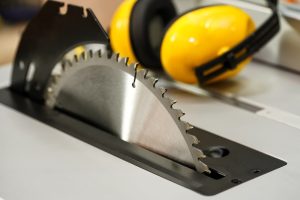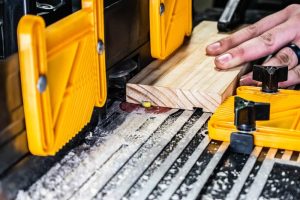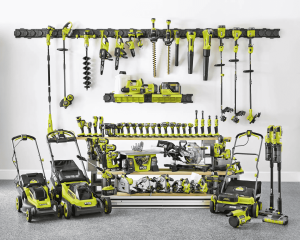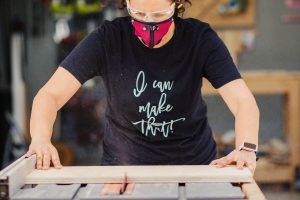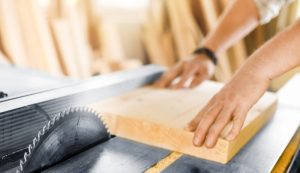For woodworkers, a router table is one of the most essential tools for achieving clean, precise cuts, decorative edges, and professional-quality joinery. But while the router itself gets most of the attention, the router table top plays a critical role in your results.
A poorly made or uneven table top can introduce vibrations, ruin accuracy, and shorten the life of your bits. On the other hand, a sturdy, flat, and durable top ensures smooth feeding, consistent depth, and a better overall woodworking experience.
With so many materials, brands, and models available, choosing the best router table top can be overwhelming. This guide breaks everything down for you—from the best materials and buying factors to detailed product reviews of the top-rated options now.
Top 5 Best Router Table Tops
What is the Best Material for a Router Table Top?
The performance and lifespan of a router table top largely depend on the material it’s made from. Here are the most common options:
Medium-Density Fiberboard (MDF) with Laminate
- Affordable and widely used.
- Smooth surface for easy feeding.
- It can sag over time under heavy use if not reinforced.
- Best for hobbyists and budget-friendly setups.
Phenolic Resin
- Stronger and more stable than MDF.
- Resistant to moisture, warping, and temperature changes.
- Provides a slick surface that minimizes friction.
- Excellent mid-range option for serious woodworkers.
Cast Aluminum
- Rigid, durable, and resistant to sagging.
- Ideal for precision routing and heavy-duty tasks.
- More expensive but worth it for long-term use.
- It can sometimes transmit more vibration compared to phenolic.
Cast Iron
- The gold standard for durability and stability.
- Extremely flat, vibration-dampening, and long-lasting.
- Very heavy and costly, often found in professional-grade setups.
For most woodworkers, phenolic resin or aluminum tops strike the best balance between performance, durability, and cost. MDF is fine for beginners, while cast iron is the ultimate choice for pros.
Key Factors to Consider When Buying a Router Table Top
Investing in the right router table top can make a world of difference in your woodworking. It affects everything from cut accuracy to ease of use and long-term durability. Below are the most important factors you should evaluate before purchasing.
Flatness and Stability
Perhaps the most crucial quality of a router table top is its flatness. Even minor warping or uneven surfaces can cause inconsistencies in your cuts, leading to inaccurate joints or decorative edges. A perfectly flat top ensures that your workpiece remains level throughout the pass, which is especially important for joinery and detailed trim work.
Stability also plays a key role. Over time, router table tops can sag under the constant weight of heavy routers or accessories. This is especially true for MDF-based tops if they are not properly reinforced. Look for tops with steel or aluminum struts underneath or materials like phenolic resin or aluminum, which naturally resist sagging. A stable and flat top doesn’t just improve accuracy—it also reduces vibrations, helping you achieve cleaner cuts with less effort.
Material and Durability
The material of the table top will determine how it performs over the years of use. Each option has advantages and drawbacks:
- MDF with laminate: Affordable and smooth, but may sag or warp with time. Best for light use or hobbyist workshops.
- Phenolic resin: More durable and resistant to moisture and warping. Provides a slick surface and performs well for mid- to high-level woodworking.
- Aluminum: Strong, stable, and lightweight compared to cast iron. It resists sagging and handles heavy-duty routing jobs.
- Cast iron: Professional-grade option. Extremely flat and stable but heavy and expensive.
When choosing a material, balance your budget, workload, and expectations. A beginner may find MDF sufficient, but professionals should consider aluminum or phenolic for long-term reliability.
Size and Compatibility
Router table tops come in various dimensions, usually ranging from 24″ x 32″ to 30″ x 40″. Larger tops give you more workspace, which is useful when routing long boards, cabinet panels, or wide stock. However, they also require more shop space and may be harder to move around.
Equally important is router compatibility. Not all tops are universal, so you’ll need to check whether your router model fits the insert plate opening. Some tops include adjustable plates or multiple pre-drilled hole patterns to fit popular brands like Bosch, DeWalt, or Makita. If you use different routers or plan to upgrade, a top with flexible compatibility will save you future headaches.
Ease of Mounting
Setting up a router table top should not feel like an engineering project. A good top comes with pre-drilled mounting holes, leveling screws, and clear instructions for attaching your router. This reduces setup time and ensures a secure, vibration-free fit.
Some higher-end models also feature adjustable mounting plates, which allow you to fine-tune the fit of your router. This not only improves compatibility but also helps you maintain a perfectly level insert plate, which is essential for consistent cutting depth.
Surface Finish
The finish of the surface directly affects how smoothly the stock glides across the table. A rough or sticky surface can cause your workpiece to catch or slow down, leading to uneven cuts or kickback.
The best router table tops feature slick, low-friction finishes such as:
- Melamine-coated MDF for affordable smoothness.
- Polished aluminum for durability and easy feeding.
- Phenolic resin for a premium, friction-resistant surface.
When comparing tops, consider how much effort it takes to push a piece of wood across the surface. The easier it moves, the safer and more accurate your routing will be.
Dust Collection Compatibility
Routing produces a significant amount of fine dust and chips, which can quickly clutter your workspace and reduce the bit life. That’s why dust collection compatibility is essential in a router table top.
Many tops integrate well with fences that feature built-in dust collection ports, while some models include pre-drilled holes or attachments for vacuum hoses. Efficient dust collection not only keeps your shop cleaner but also improves visibility during cuts and reduces the risk of inhaling harmful particles.
Price vs. Longevity
Finally, weigh the cost of the top against its expected lifespan. While MDF tops are the cheapest, they are also the most likely to warp or sag over time, especially with heavy routers. If you’re a hobbyist who uses the router occasionally, an MDF top might be perfectly fine.
For frequent use or professional-level work, investing in aluminum or phenolic resin pays off. Though they come at a higher upfront cost, these materials will last much longer, provide greater accuracy, and require less maintenance. Think of it as a long-term investment in your woodworking precision.
Final Thoughts on Buying the Right Router Table Top
The best router table top balances flatness, durability, compatibility, and ease of use. Whether you’re a beginner looking for an affordable MDF model or a seasoned woodworker ready to invest in aluminum or phenolic, keeping these factors in mind will help you make a confident, informed decision.
Kreg PRS1025 Router Table Top

The Kreg PRS1025 is one of the most popular router table tops on the market, designed for woodworkers who demand precision without breaking the bank. Built with a 1″-thick MDF core and high-pressure laminate surface, it ensures smooth stock movement and minimizes friction.
The top measures 24″ x 32″, offering ample workspace for large projects. It comes with a router insert plate opening and pre-drilled leveling screws for secure installation. The edge-banded surface prevents warping, while the reinforcing steel struts underneath enhance stability.
Whether you’re routing dados, grooves, or decorative edges, this table top offers both durability and affordability in one package.
Key Features
- 1″-thick MDF with high-pressure laminate.
- Steel-reinforced support struts.
- Pre-drilled insert plate leveling screws.
- Generous 24″ x 32″ working surface.
Pros
- Affordable yet reliable.
- Flat and stable for precision work.
- Easy to set up with most router plates.
Cons
- MDF core may sag with very heavy routers.
- Not as durable as aluminum or phenolic.
JessEm Mast-R-Top Phenolic Router Table
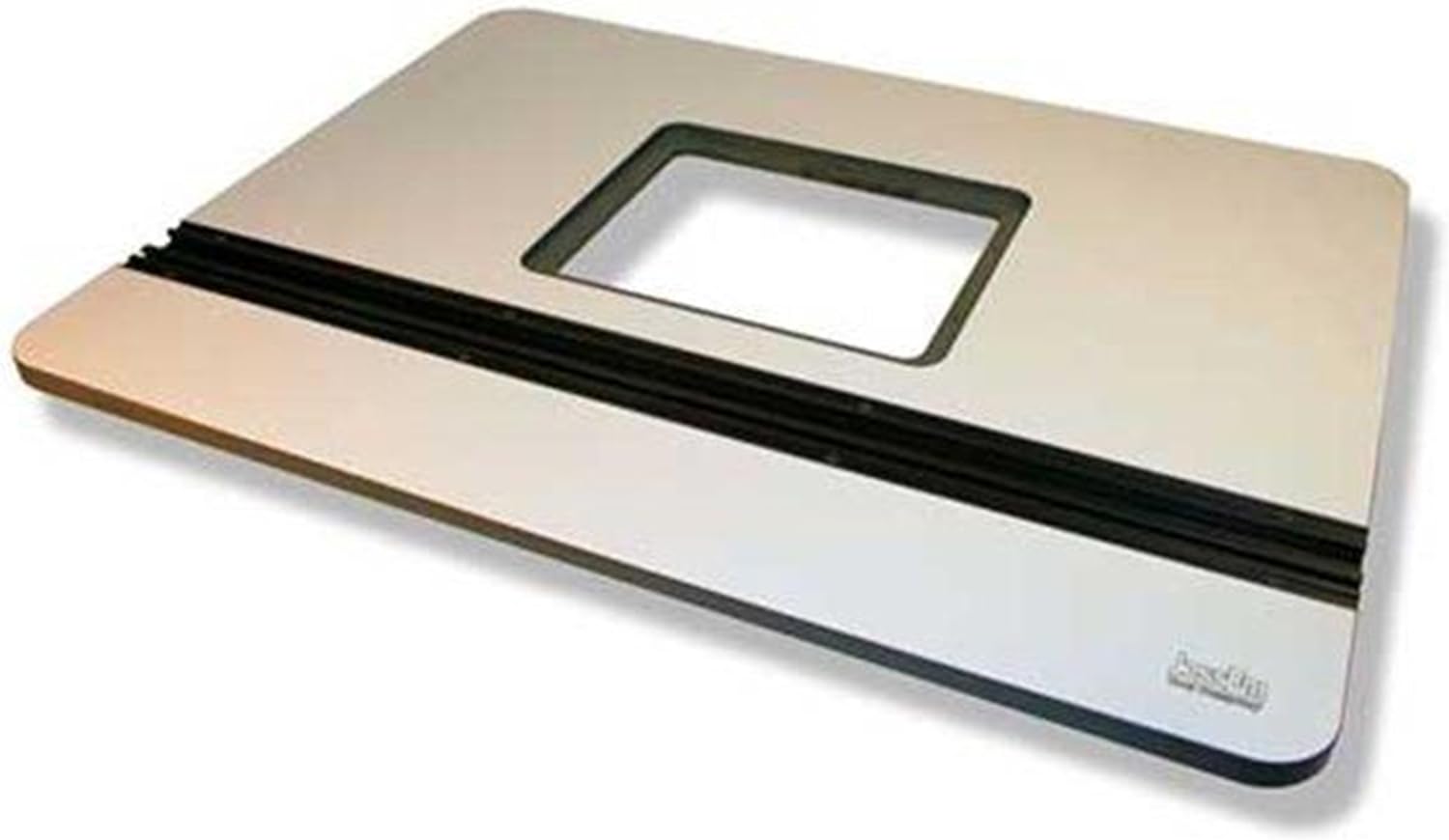
The JessEm Mast-R-Top is crafted from premium phenolic resin, making it exceptionally strong, warp-resistant, and moisture-proof. Measuring 24″ x 32″, it provides a robust working area suited for both hobbyists and professionals.
Unlike MDF, phenolic resin holds up against heavy routers without sagging. The top also features precision-machined inserts for compatibility with most router plates and lifts.
With its glossy, low-friction surface, workpieces slide effortlessly, improving accuracy and safety. For woodworkers seeking a long-lasting upgrade that bridges the gap between MDF and cast aluminum, the Mast-R-Top is a solid investment.
Key Features
- Phenolic resin construction.
- 24″ x 32″ dimensions.
- Pre-drilled insert opening.
- Moisture and warp-resistant.
Pros
- Extremely durable and stable.
- Resistant to sagging over time.
- Slick surface for easy feeding.
Cons
- Pricier than MDF tops.
- Heavier than aluminum models.
Elestoria Aluminum Router Table Top
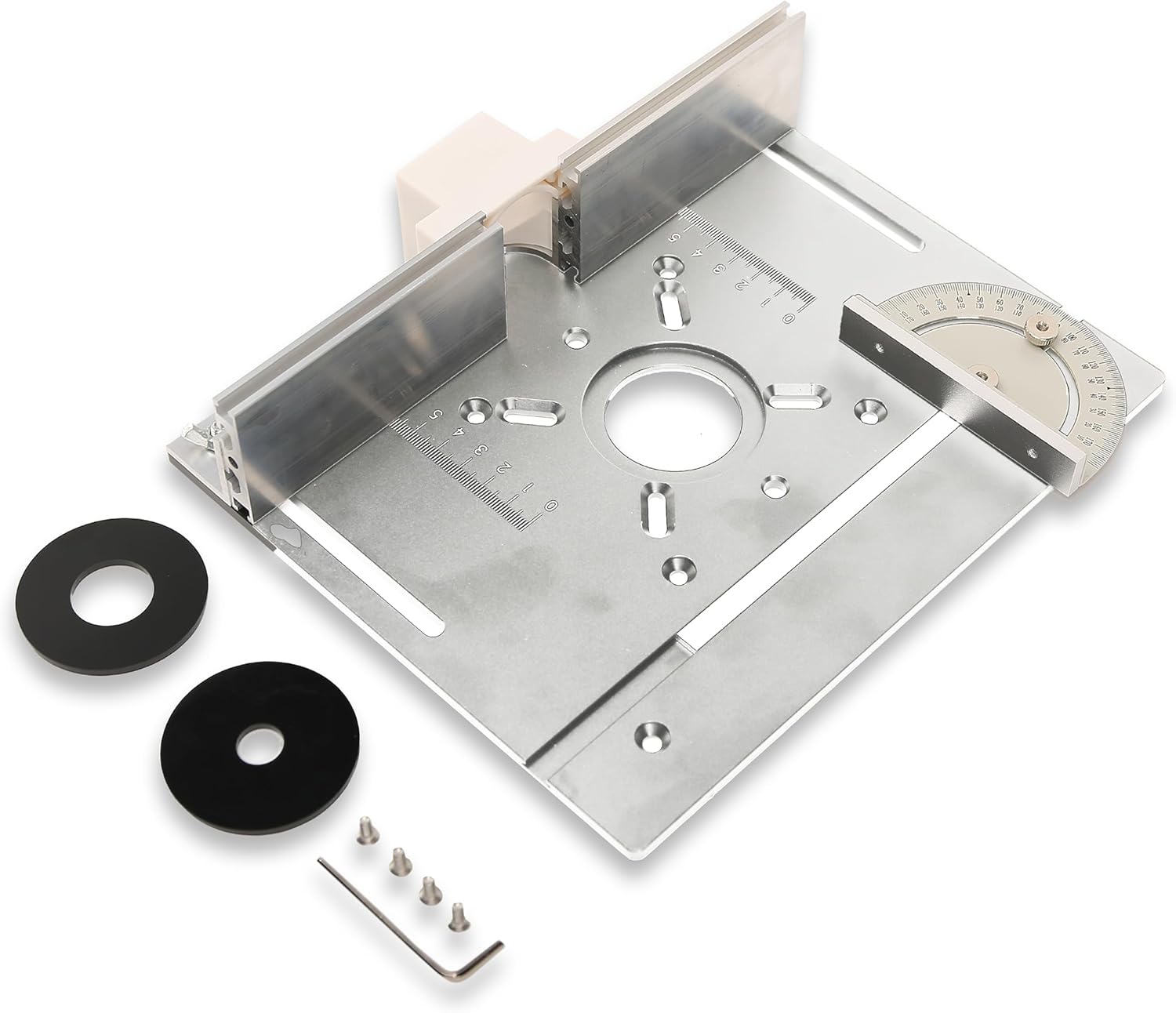
For those seeking the durability of metal, the Elestoria Aluminum Router Table Top is a versatile choice. Constructed entirely from precision-machined aluminum, it provides a perfectly flat, warp-resistant surface that can handle heavy-duty routing.
Measuring 23.6″ x 17.7″, it’s compact yet sturdy, making it ideal for smaller shops or portable setups. The top includes multiple pre-drilled mounting holes, three-hole adjustment support, and engraved measurement scales for added convenience.
Its corrosion-resistant finish ensures long life, while the rigid build eliminates vibrations that can affect cut quality. This model is perfect for serious hobbyists and professionals who want reliability and precision in a compact package.
Key Features
- Solid aluminum construction.
- Engraved measurement guides.
- Multiple pre-drilled mounting holes.
- Compact and portable size.
Pros
- Extremely durable and stable.
- Precision-machined for accuracy.
- Corrosion and warp-resistant.
Cons
- Smaller surface compared to MDF/phenolic tops.
- Higher price point for its size.
OSKOOL MDF Router Table Top

The OSKOOL MDF Router Table Top is a budget-friendly solution for beginner woodworkers or those setting up a simple shop. Built from MDF with a laminated surface, it offers smooth stock feeding and decent stability for light to medium-duty routing tasks.
Its 30″ x 18″ size provides enough space for most DIY projects, and it comes with a pre-cut insert plate opening for easy router mounting. While it won’t match the long-term durability of phenolic or aluminum, it delivers good value for hobbyists who don’t need heavy-duty performance. If you’re on a tight budget but want a functional router table top, OSKOOL is a smart choice.
Key Features
- MDF with laminated coating.
- Pre-cut router plate opening.
- 30″ x 18″ working area.
Pros
- Very affordable.
- Smooth surface for easy work.
- Lightweight and easy to install.
Cons
- Susceptible to sagging over time.
- Not ideal for professional use.
Aluminum Router Table Top
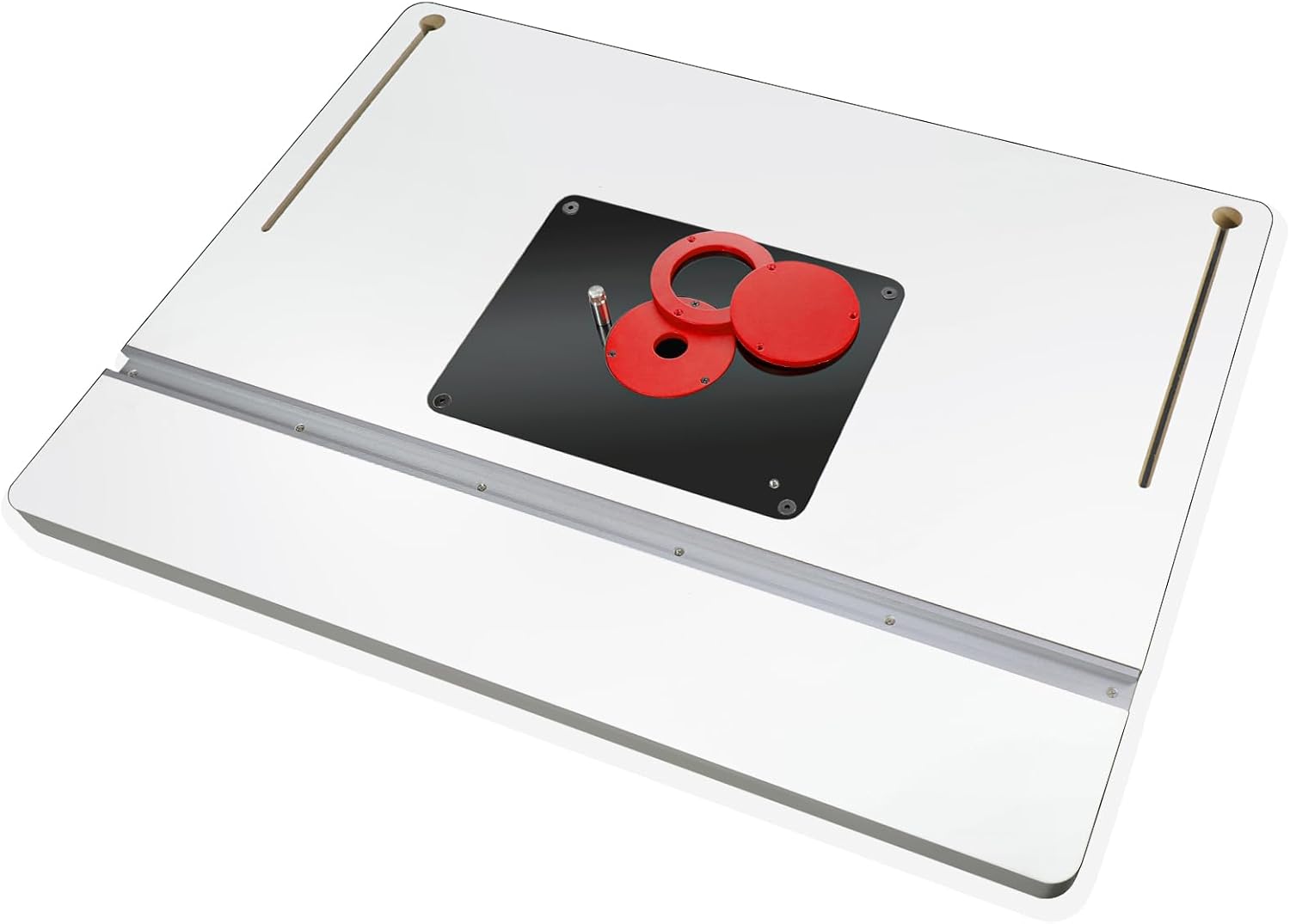
This Aluminum Router Table Top is designed with precision and durability in mind. Featuring a full-metal body, it provides excellent rigidity, ensuring cuts remain accurate over extended use.
The standout feature is its three-hole adjustment system, which allows fine-tuning and secure router placement. Measuring 23.6″ x 17.7″, it’s similar in size to the Elestoria but focuses on adjustable versatility.
The engraved measurement scales help ensure precision, while the included mounting screws make setup straightforward. Perfect for woodworkers who want adjustability and a long-lasting surface, this router table top combines convenience with professional-grade durability.
Key Features
- Solid aluminum build.
- Three-hole adjustment system.
- Pre-marked measurement scales.
- Includes mounting screws.
Pros
- Rigid, stable, and long-lasting.
- Adjustable mounting for precision.
- Smooth feeding surface.
Cons
- Smaller surface area than MDF/phenolic tops.
- Heavier than MDF options.
FAQ Section (People Also Ask)
When shopping for the best router table top, many woodworkers have similar questions. Below, we’ve expanded on the most frequently asked queries to give you a clear understanding of what matters most.
What is the smoothest surface for a router table top?
The smoothness of a router table top plays a big role in how easily stock moves across it. A slick, low-friction surface allows for controlled feeding without catching or resistance, which not only improves cut quality but also reduces the risk of accidents.
Among all materials, phenolic resin tops are widely regarded as the smoothest. This engineered material is designed with a polished, durable finish that resists scratches and wear. Because the surface is naturally low-friction, workpieces glide with minimal effort, reducing strain on both the user and the router bit. Over time, this results in less wear on your cutting edges and more precise, consistent routing.
In comparison, laminated MDF also provides a fairly smooth surface but can lose its slickness as the laminate wears. Aluminum tops are smooth as well, though they may transfer vibrations more than phenolic. If smoothness and longevity are your top priorities, phenolic resin offers the best balance.
Can I use plywood for a router table top?
Technically, yes—you can use plywood for a router table top, but it’s not the most reliable material. Plywood’s layered construction makes it prone to warping, sagging, or delamination over time, especially under the continuous weight of a router and accessories. Moisture and humidity also affect plywood more than MDF, phenolic, or aluminum.
Some hobbyists build DIY router tables using plywood reinforced with hardwood edging or steel braces. While this can work as a short-term solution, it doesn’t compare to the stability and longevity of professional-grade materials.
If you’re on a budget, MDF with a laminate coating is usually a better alternative—it provides a flatter surface and smoother feeding than basic plywood. For serious woodworkers, investing in phenolic resin or aluminum ensures a router table top that will remain flat, stable, and accurate for years.
How thick should a router table top be?
Thickness is critical when it comes to stability. A thin top is more likely to sag under the weight of the router motor, fence, and workpieces. Once a table sags, it throws off your cutting depth and alignment, which compromises accuracy.
Most quality router table tops are at least 1 inch thick. This is generally considered the minimum to ensure structural stability. Many MDF tops are built to this thickness and reinforced with steel or aluminum struts underneath to prevent bowing.
For materials like phenolic resin or aluminum, a slightly thinner top can still provide adequate strength because these materials naturally resist warping. However, the thicker the top, the more stable and vibration-resistant it will be. If you plan to use heavy-duty routers or lifts, always opt for a reinforced top at least 1 inch thick, ideally with additional support bracing.
Is a bigger router table top always better?
At first glance, it might seem like a larger top is always superior—it gives you more room to maneuver long boards, cabinet panels, and wide workpieces. While it’s true that larger tops (30″ x 40″ or more) offer better support for big projects, there are trade-offs to consider.
- Workshop space: Larger tops require more floor or bench space, which may not be practical in smaller workshops or garages.
- Portability: If you need to move your router table around or take it to job sites, a compact top (around 24″ x 32″) will be much easier to handle.
- Cost: Bigger tops often come with a higher price tag, especially in premium materials like phenolic or aluminum.
In short, bigger is only better if you regularly work on large projects and have the room to accommodate it. For hobbyists or woodworkers in smaller shops, a medium-sized table top with good stability is often the smarter choice.
Do router table tops come with insert plates?
This depends on the brand and model. Some router table tops are sold as complete kits with a pre-installed insert plate, while others are sold as just the flat top surface with a cutout for a plate.
Insert plates are essential because they allow you to mount the router securely while keeping it level with the table surface. Many plates are also removable, which makes it easier to change routers, adjust bits, or perform maintenance.
Before purchasing a top, check the product description carefully:
- Some tops include a universal plate compatible with multiple router models.
- Higher-end models may not include a plate, giving you the freedom to choose one that matches your router brand or lift system.
- Budget MDF tops often include a basic plate, but it may not fit heavy-duty routers.
If a plate is not included, make sure the cutout size matches the plate you plan to buy. Investing in a high-quality insert plate with leveling screws ensures your router sits flush with the top, which is critical for accurate routing.
Conclusion
The right router table top can transform your woodworking projects by improving accuracy, stability, and ease of use. For budget-conscious buyers, the OSKOOL MDF Top is a solid entry-level option.
If you want a step up in durability, the JessEm Mast-R-Top Phenolic offers professional-grade performance. For those who demand maximum precision and strength, the Elestoria and Aluminum Three-Hole Adjustment Tops are excellent investments.
Ultimately, the best choice depends on your budget, workspace, and how often you plan to use your router table. With the options reviewed above, you’re sure to find a top that fits your needs and enhances your woodworking results for years to come.
